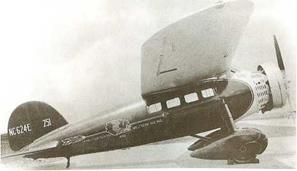Lockheed Vega 5 and Orion 9E
6 seats • 150 mph
6 seats • 180 mph
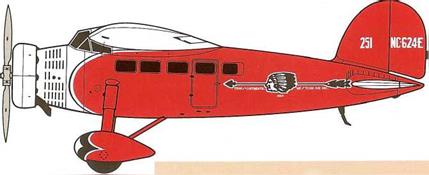


VEGAS
Engine Pratt & Whitney Wasp (420 hp) MGTOW 4,2171b.
Range 600 miles
Length 27 feet
Span 41 feet
ШСКНЕІІ SINGLE-ENGIMSD FLEET
|
Fleet |
Delivery |
|||
|
No. |
Regn. |
MSN |
Date |
Remarks and Disposal |
|
Vega L-l |
NC6525 |
9 |
Jul 28 |
Type 1, converted to 5C. Used by Maddux Air Lines for charter work, especially for motion picture companies. Sold after accident at San |
|
Diego mid-1929 |
||||
|
L-2 |
NC7044 |
11 |
Aug 28 |
Type 1, converted to use R-685 engine. Also with Maddux until merger with T. A.T. Sold 1930 and used by several owners. Flown as a "rum runner" from Oklahoma to neighboring "dry" states. |
|
Scrapped 1952. |
||||
|
251 |
NC624E |
53 |
11 Dec 31 (into service) |
Type 5. Sold to Hanford’s Tri-State Airlines. |
|
253 |
NC497H |
135 |
1931 |
Type DL-1B. Built by Detroit Aircraft Corp. Written off, 31 Jan 34, after forced landing, St. James, Missouri |
|
254 |
NC288W |
137 |
1932 |
Type DL-1B. Sold to Hanford’s 1934 |
|
255 |
NC483M |
136 |
Mar 32 |
Type DL-1 B. Sold to Varney Speed Lines, 24 Jul 34 |
|
Altair BL-2A |
||||
|
252 |
NCI 2222 |
180 |
Sep 1931 |
Leased from manufacturer. Crashed at Columbus, Ohio, 10 Oct 31. Subsequently many owners, including Paul Mantz. Unservicable after 1965 |
|
Orion 9E |
||||
|
256 |
NCI 2277 |
192 |
11 May 33 (into service) |
Crashed into Missouri River, Kansas City, 28 Jul 33 |
|
257 |
NCI 2278 |
193 |
11 May 33 |
Crashed near Albuqueque, 15 Jan 34 |
|
258 |
NCI 2283 |
195 |
11 May 33 |
Withdrawn from service, Feb 35 |
Faster Mail
T. W.A. had a few Vegas from the end of 1931, but used them mainly for mail, as the DC-2s soon made them redundant. Even so, Lockheed was establishing a reputation for building fast aircraft, and in 1933, Air Express, Inc., was operating a speedy transcontinental mail and express service, at first with Vegas, but even more successfully with Orions (see page 37).
|
The Lockheed Vega was the first of several single-engined, mainly wooden, Lockheed types that, for a short time (until the introduction of the Douglas DC-2) carried the transcontinental air mail faster than the Ford Tri-Motors. |
The Urge for Speed
During the late 1920s, the contrast between the speed of racing airplanes and the slow, 100 mph (on a good day) Fords was becoming more evident, as the former types improved every year. Designed by John K. Northrop, the Lockheed Vega offered a practical compromise. Built of wood, and efficiently streamlined, it could fly much faster than the Ford, and could—unlike the racers—carry six passengers. Also, it cost only $17,500. The airline authority, Edward P. Warner, estimated that the better speed compensated for the smaller size, so that the operating costs per seat-mile were about the same as the Ford’s.
|
The Lockheed Orion was the metal-built development of the original Vega. It is seen here during the winter of 1933/34 with, in the rear, a Northrop Alpha. |
![]()
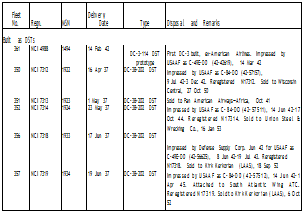
 A World-Beater
A World-Beater
The Douglas DC-2 had been an instant success, surpassing all other transport aircraft in performance and offering an unprecedented standard of airliner comfort. It had achieved everlasting fame when the Dutch airline, K. L.M., entered it for the England-Australia Air Race in October 1934, and to the astonishment of the world, came in second, among a field of specially-designed racing and sporting aircraft. Moreover, it carried four passengers and a load of mail, and stopped at all the K. L.M. stations along the route. This led to export orders for Douglas, to Europe, Australia, and to China.
The DST
While T. W.A.’s Tommy Tomlinson was conducting his experiments with the Northrop Gamma (see page 37) in search of faster and smoother high-altitude flight “above the weather,” one of the rival transcontinental airlines was concentrating on other directions of competitive rivalry and excellence. Bill Littlewood, of American Airlines, recommended the development of the Douglas DC-2 by widening the fuselage, not only to make room for 14 bunk beds, but also to accommodate three abreast seating instead of two (21 v. 14). The first Douglas DST went into service between New York and Chicago on 25 June 1936; and a dramatic new era had begun.
Interestingly, this first service was as a dayplane, but the aircraft fulfilled its original design purpose when American received its first Douglas DC-3 and the transcontinental skysleeper service began on 18 September 1936.
The Great DC-3
With its fleet of 31 DC-2s, T. W.A. had less need for the larger Douglas DC-3 than did the other U. S. airlines. United Air Lines, for example, in spite of its close Boeing heritage, had to buy the Douglas flagship, and introduced it between Los Angeles and San Francisco on 1 January 1937. It followed with a luxury 14-seat daytime service on New York-Chicago in February, and then put the DST on its transcontinental route in July.
The DST, as Donald Douglas had warned, did not meet with the outstanding success that had been predicted; but the DC-3 exceeded all expectations. American’s president, C. R. Smith, claimed that it was the first airliner to be able to make a profit without the benefit of air mail payments. This was with the equivalent of today’s first-class fare levels and no doubt with every seat filled; but it was nevertheless a measure of its overwhelming superiority. It became, in various versions, the standard transport aircraft for the U. S. and
Allied forces in the Second World War; and was built under license in the Soviet Union and Japan. Of all types, 10,926 were built in the United States, 487 in Japan, and 6,157 (as Lisunov Li-2s) in the Soviet Union.
T. W.A/S DC-3s
Jack Frye had to supplement his DC-2 fleet with the more efficient DC-3s. The first one, a DST, entered service from New York to Los Angeles on 1 June 1937. Dayplanes were also
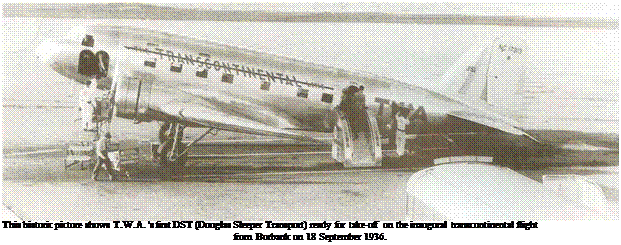 added on all routes during that summer, and the addition of the extra capacity could not have come at a better time. T. W.A. gained more direct access to San Francisco from Winslow, via Las Vegas; and restored its link with Chicago from Dayton, via Fort Wayne. The old “Gooney Bird” served T. W.A. well before, during, and after the War. The fleet list, spread over this and the next two pages, totalled 104 aircraft, of which 14 were DSTs, 34 DC-3s, 12 military C-49s (conversions of DC-3s), and 43 military C-47s and C-53s (postwar converted DC-3s).
added on all routes during that summer, and the addition of the extra capacity could not have come at a better time. T. W.A. gained more direct access to San Francisco from Winslow, via Las Vegas; and restored its link with Chicago from Dayton, via Fort Wayne. The old “Gooney Bird” served T. W.A. well before, during, and after the War. The fleet list, spread over this and the next two pages, totalled 104 aircraft, of which 14 were DSTs, 34 DC-3s, 12 military C-49s (conversions of DC-3s), and 43 military C-47s and C-53s (postwar converted DC-3s).
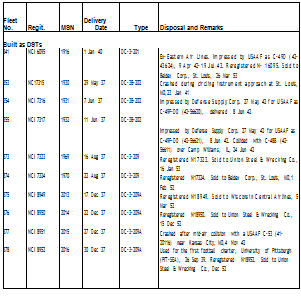
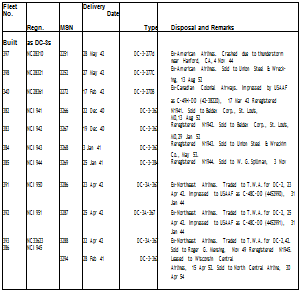
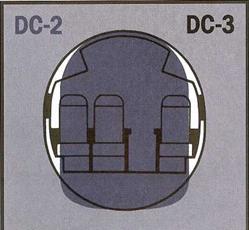 |

![]()
 |
DOUGLAS B£»3 FLEE! LIST (ronfsaued)
In airliner development, the fuselages are invariably lengthened.
The transition from DC-2 to DC-3 was an exception—and an
aerodynamic improvement.
|
||||||||||||||||||||||||||||||||||||||||||||||||||||||||||||||||||||||||||||||||||||||||||||||||||||||||||||||||||||||||||||||||||||||||||||||||||||||||||||||||||||||||||||||||||||||
 |
||||||||||||||||||||||||||||||||||||||||||||||||||||||||||||||||||||||||||||||||||||||||||||||||||||||||||||||||||||||||||||||||||||||||||||||||||||||||||||||||||||||||||||||||||||||
 |
||||||||||||||||||||||||||||||||||||||||||||||||||||||||||||||||||||||||||||||||||||||||||||||||||||||||||||||||||||||||||||||||||||||||||||||||||||||||||||||||||||||||||||||||||||||
|
||||||||||||||||||||||||||||||||||||||||||||||||||||||||||||||||||||||||||||||||||||||||||||||||||||||||||||||||||||||||||||||||||||||||||||||||||||||||||||||||||||||||||||||||||||||
|
||||||||||||||||||||||||||||||||||||||||||||||||||||||||||||||||||||||||||||||||||||||||||||||||||||||||||||||||||||||||||||||||||||||||||||||||||||||||||||||||||||||||||||||||||||||


 DC-1 (length 60 feet)
DC-1 (length 60 feet)
The DC-1 (and the DC-2) were distinguished from the later aircraft by the narrow, flat-sided fuselage, and small vertical stabilizer. The DC-1 had six cabin windows per side. Powered by two 650-hp Wright Cyclone engines, it was a giant airplane for its day (see pages 33-35).
DC-2 (length 62 feet)
The DC-2 added one more cabin window to each side. Engine horsepower was improved to 800 hp, and larger landing lights were added to the nosecone. All other structural details were quite similar to those of the DC-1 (see pages 34-35).
 BST/OC-3 (length 64.5 feet)
BST/OC-3 (length 64.5 feet)
The DST had a longer and wider cabin, with one more window added to the DC-3 version, and an eighth cabin window on the left side of the aircraft for the DST. Most noticeable feature of the ‘sleeper’ DST was the small horizontal “bunk” windows above the main window line (see pages 38-40).

C-47 (length 64 feet)
The most abundantly produced version of the DC-3 family, this military aircraft was considered by General Eisenhower to be one of the most essential pieces of machinery of the Second World War. Note the addition of cowl flaps, highly modified engine nacelles and tailcone, and a glass ‘astrodome, ’ through which navigators took celestial and solar sightings.











